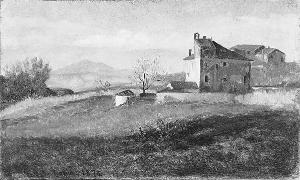George Henry Yewell
George Henry Yewell
Place: Havre De Grace
Born: 1830
Death: 1923
Biography:
George Henry Yewell (20 January 1830 – 26 September 1923) was an American painter and etcher. Yewell was born in Havre de Grace, Maryland. His father died when he was a boy, and he and his mother left Maryland for Cincinnati, as she had family there; in that city he received some instruction from Theodore S. Parvin, who later became a prominent educator in Iowa. In 1841, mother and son moved again to Iowa City, Iowa, where other members of their extended family lived. In 1848, Yewell apprenticed himself to a tailor to learn a trade, but at that same time he began showing an interest in art; a formative experience early in life was his encounter with a suite of prints based upon the cycle The Voyage of Life by Thomas Cole. His breakthrough came with a political cartoon he drew about the controversy surrounding the move of the state capital from Iowa City to Des Moines. He later described the incident: At the height of the excitement, I drew a large caricature, representing the Capitol building on wheels, and oxen pulling one way, upon whose shoulders were placed heads of members who voted for removal. On the other end of the building were those members who voted against the bill, represented by oxen whose feeble chain had broken and tumbled them in a heap. Principal leaders of the movement were represented as drivers; bodies of different animals, suited to their different characters, being in place of their own. The likenesses were easily recognized and the caricature created a sensation. It went from town to town over the state and made me widely known. Among those who took notice of the young artist was Charles Mason, Chief Justice of the Iowa Supreme Court. He collected a group of associates and together they financed the young man's move to New York City for the formal study of art. Charles Anderson Dana provided him with a letter of introduction to Thomas Hicks, whose pupil he became, and in whose studio he met William Makepeace Thackeray. He then enrolled in the school of the National Academy of Design, which he attended from 1851 until 1853. After his period of study, Yewell returned to Iowa City and painted portraits, specializing in depictions of children. By January 1856 he was back in New York and re-enrolled at the academy; he took a studio in the city at this time as well. That July he went to Paris, again supported by Mason and his friends; until 1861 he studied there with Thomas Couture and counting among his acquaintances fellow students Henry A. Loop and Thomas Satterwhite Noble. A copy which he made of a painting by Rosa Bonheur during this time won him much acclaim from his fellow artists. In 1862 Yewell was in Iowa again, taking studio space in Des Moines, but by that spring he was back in New York, with a studio in the Dodsworth Building, when he submitted five works to the annual exhibition of the National Academy. At least three of the pieces in question were genre scenes dating to his French sojourn. Yewell never returned to Iowa to live, though he visited regularly, and married a local woman, Mary Elizabeth (Mollie) Coast, in 1863. With his wife and her brother Oscar he returned to Europe in 1867, and took up residence in Rome; he spent summers in Perugia and Venice and traveled to Egypt in 1875, and returned to the United States in 1878. Among his friends in Rome were Elihu Vedder, Charles C. Coleman, and Bayard Taylor. It is suspected that Yewell returned to the United States due to the behavior of his wife, who had shocked the American expatriate community in Rome; the couple were divorced the next year, and she married the English painter Edwin Ellis.Yewell maintained deep ties with his patrons from Iowa, and earned many portrait commissions from them; even so, upon his return to America settled in New York City, where the chances of finding work were better. He rented a studio in the Tenth Street Studio Building, which he kept at least until 1880. He returned the


